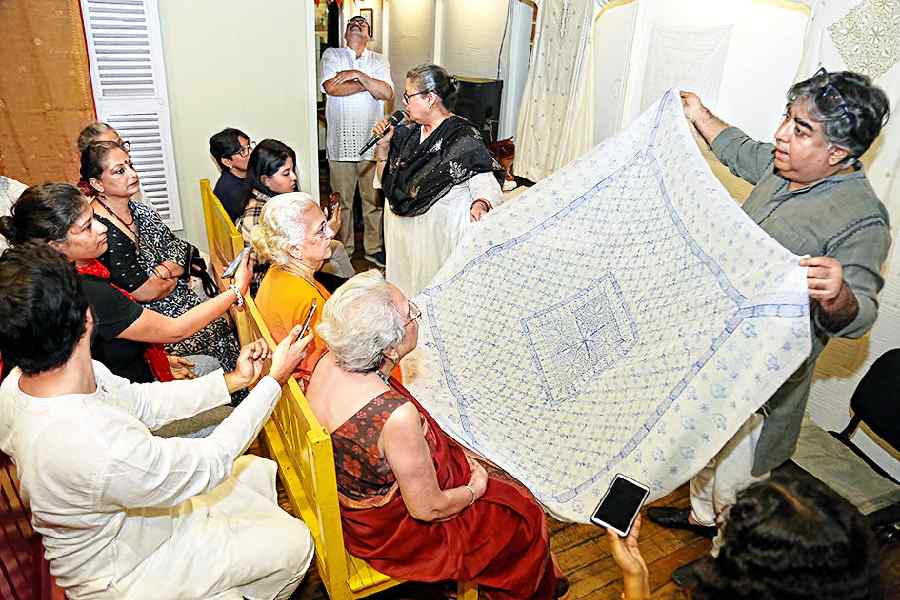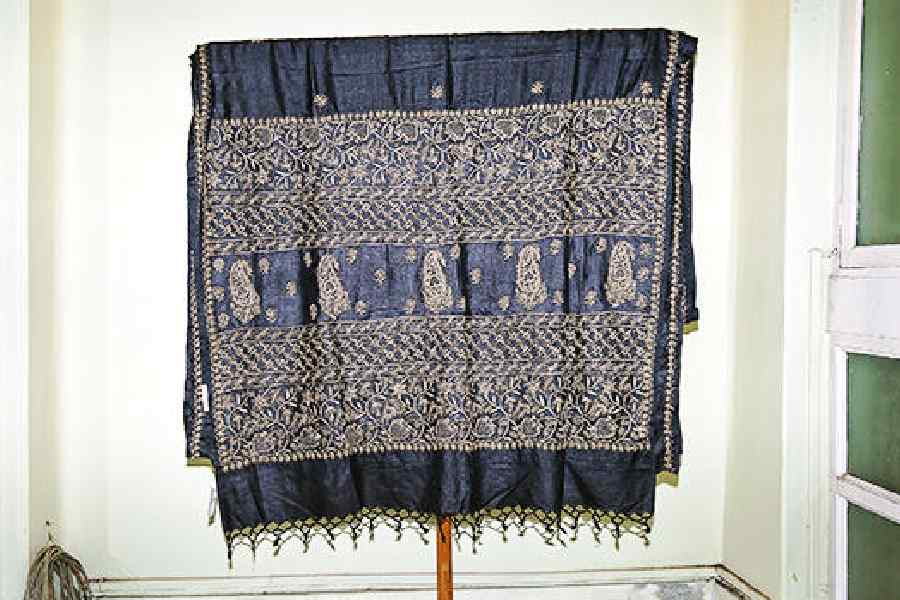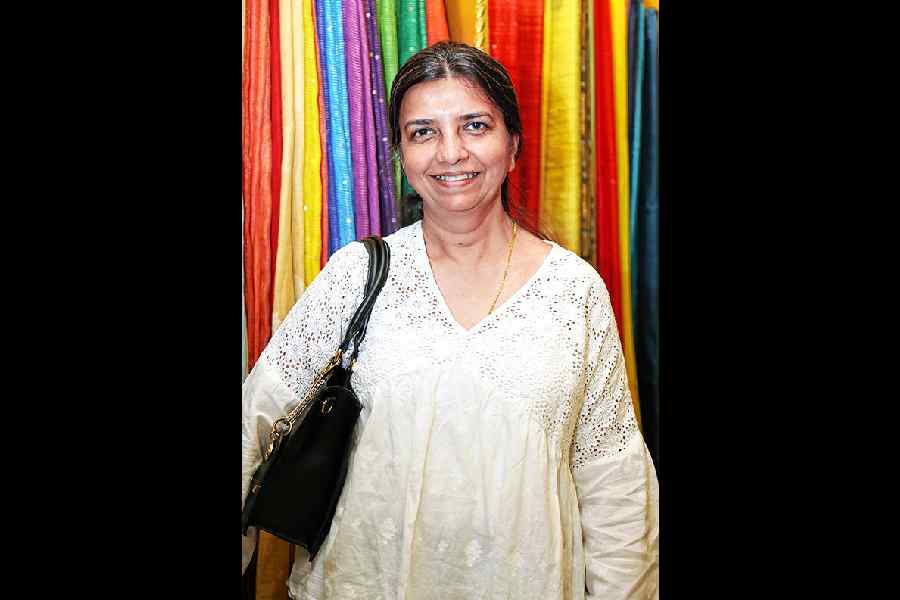Byloom, for their latest event, welcomed textile lovers and chikankari enthusiasts of Calcutta to engage in a discussion with and listen to Delhi-based textile expert Malavika Neogi Chatterjee talk about her three-decade-old passion project of working with the delicate craft of Lucknowi chikankari. The talk was hosted by Bappaditya Biswas of Byloom. Malavika also presented her UNESCO award winning chikankari designs and a collection of saris, dupattas, three-piece sets and fabrics over a three-day showcase.
The History:

A sample of print done with ink was showcased to make the audience comprehend how chikankari work is done following the designs on the piece of cloth
Chatterjee spoke about the grandeur and richness of this embroidery style, besides its history and artistry that have been comparatively less talked about in the fashion industry. Talking about the origin of this design, she said: “Lucknowi chikankari’s origin is shrouded in mystery. There are absolutely no records. However, there is a popular belief that Empress Nur Jahan was an expert in different forms of Persian embroidery and she brought the craft with her from Persia. As the empress had a keen interest in several embroidery styles, she once made a Dopalli topi for her husband and the then Mughal emperor Jahangir. He was thoroughly enamored by the craft and that’s how it all started. From Nur Jahan it passed on to the hands of many other women in the Mughal courts who were trained in the art of making this textile.”
The Initial Craft:
Lucknowi chikankari work was basically done on Dhakai muslin and other very fine muslin which were quite expensive at that time. “Chikankari in one sentence can be called a white-on-white canvas that is basically done on Dhakai muslin and kachha tar, which means untwisted super fine raw thread. It is generally used in weaving embroidery. At present, there are hardly a handful of karigars who are engaged in weaving this textile.” Malavika showcased some samples which were done in single threads. One of them was an angrakha.

A sari comprising janjira, ghas patti, phanda, murri, pechni, badla, jaali, and kaamdani stitches
Intricacies of the Craft:
“Lucknowi chikankari is the only embroidery form which visibly has 42 stitches, most of which are not being recorded. Each and every stitch has its own uniqueness and there are also different karigars for different types of stitches. The karigar who does the bakhiya or the shadow work doesn’t do the emboss or other types of chikankari stitches. The fabric passes on from one hand to the other and then a particular garment comes out as a final piece. One particular muslin might contain more than one stitch and that’s how the final product is made,” she said. The saddest part of this craft, as Malavika points out, is that the karigars do not teach this craft to anyone except their family members. So they want their skills or artistry to closely remain within territorial boundaries.
Talking about how her love affair with chikankari started at a young age with a white kurta that her father got for her, she further mentioned the speciality of the chikankari from Lucknow. “This particular chikankari from Lucknow is so famous because there are no other chikankari in the world which can boast of so many stitches. The basic stitches being bakhiya and tepchi,” she said.
Briefly introducing the various types of stitches involved, she shed light upon the jaali work as an intrinsic part of Lucknowi chikankari, “A jaali is a very specialised stitch of chikankari. It is not something where the fabric is cut. The fabric remains as it is. The weave is done with a third thread that forms the minute holes. This gives a beautiful effect to the embroidery. It is believed that the inspiration behind making these jaalis has come from Turkish architecture. That is also highly reflective in Mughal architecture which has influences of both Turkey and Persia.”
Explaining the process of creating it, she said: “It’s a very elaborate process. We choose the type of fabric and then the motifs that will go into it. Every fabric reacts differently. All fabrics cannot take all kinds of stitches. For a thicker fabric it is quite impossible to do shadow work or extensive jaali work in it. Thus, chikankari work is a stitch-specific craft in fabric. The role of the washerman cannot be absolutely undermined. The finishing of the final garment will depend on how the washerman handles the material. Post washing, the loose ends of the thread are cut on the reverse side, ironed well and then presented in the market for sale.”
The trends in fashion that chikankari inspired:

“Our concept of Lucknowi chikankari textile has been very different, which is generally based on what we see in the market. Today it has been an eye-opener because we have learnt so many things and so many kinds of stitches. It was a really wonderful talk put together and I am really very happy being here at the store,” said Mayuri Mody Doshi, a textile enthusiast.
Lucknowi chikankari flourished in the Awadh region and the nawabs of Awadh are greatly responsible for nurturing and most importantly patronising the art. “Layered dressing was the fashion of the age wherein men, especially nawabs, wore chogha. Most of the garments were embroidered with chikankari. All chikankari garments that were worn during summers were entirely handmade ascribing to the absence of machines in those times… a farsi pyjama was also worn by the women then to replicate the gowns worn by the British,” said Malavika.
Identifying the craft:
Bappaditya, who moderated the conversation, initiated the discussion on identifying real and fake chikankari. “Lucknowi chikankari got the GI tag in 2008. There are also a variety of chikankari works that are being done outside Lucknow. Computerised machine-made chikankari may look like a chikankari but it is not so because the motifs are entirely different. Also, if you see the reverse of the fabric, a machine-made chikankari will not have these knots and threads. The uniformity of machine-made chikankari is the actual test to identify the real and the fake one,” said Malavika.
Malavika concluded the talk by mentioning how contemporary narratives of this craft are welcomed but as a heritage craft, it still needs wider acceptance.
